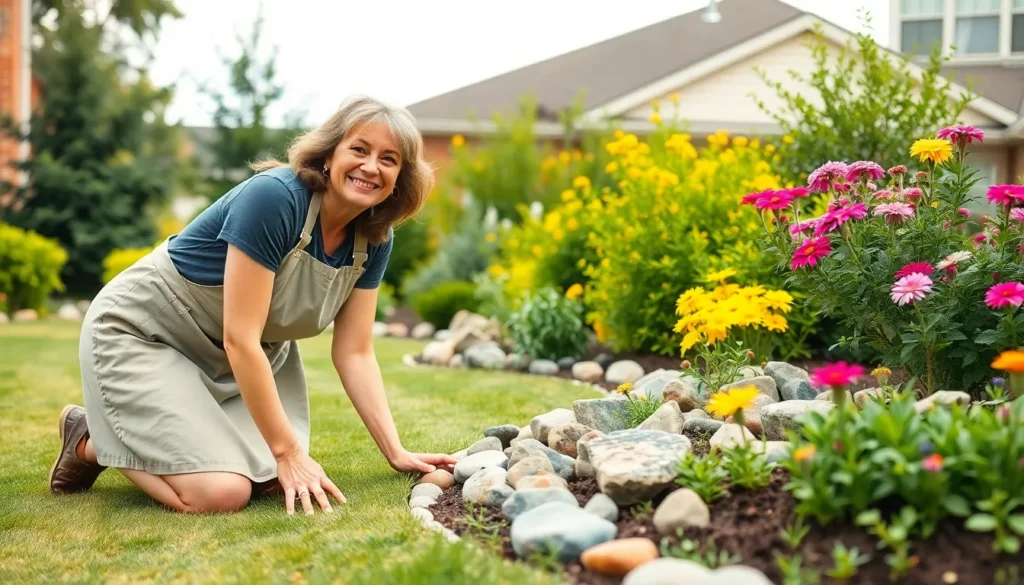We’ve all stood in our yards wondering how to make our landscaping look more polished and professional. The secret often lies in one simple element that many homeowners overlook: quality edging. Whether you’re dealing with unruly grass creeping into flower beds or searching for ways to define your garden spaces, the right edging transforms ordinary landscapes into stunning outdoor showcases.
From classic brick borders to modern metal strips, we’ll explore creative answers that work with any budget and style preference. Smart edging choices don’t just improve your home’s curb appeal – they also reduce maintenance time by keeping mulch in place and preventing weeds from spreading between different industry zones.
Ready to discover edging ideas that’ll make your neighbors wonder how you achieved such a professional look? We’re sharing proven techniques and innovative materials that turn basic yard maintenance into an opportunity for serious industry enhancement.
Define Your Garden Boundaries With Classic Brick Edging
Brick edging remains one of our most trusted landscaping answers for creating clean garden lines. This timeless material transforms ordinary yard spaces into professionally designed outdoor areas.
Traditional Red Brick Installation
Traditional red brick installation starts with proper ground preparation and precise measurements. We recommend digging a trench 4 to 6 inches deep along your desired garden border to ensure stability and longevity.
Lay each brick end to end in your prepared trench, maintaining consistent spacing between units. Check alignment frequently using a string line or level to create perfectly straight edges that enhance your industry’s visual appeal.
Backfill soil firmly around each brick while leaving approximately 2 inches of height visible above ground level. Pack the surrounding area with a rubber mallet to eliminate air pockets and secure your new garden boundary.
Apply industry fabric behind the brick edging to prevent weeds from growing through gaps. This additional step reduces future maintenance while preserving your garden’s clean appearance for years.
Recycled Brick for Rustic Appeal
Recycled brick offers character and sustainability that new materials simply can’t match. We’ve found these weathered bricks create charming cottage garden aesthetics while reducing environmental impact.
Source reclaimed bricks from demolition sites, architectural salvage yards, or online marketplaces for authentic aged appearance. Each piece tells a unique story through chips, stains, and weathering patterns that add visual interest to your industry design.
Mix different brick sizes and colors within your installation to achieve natural, organic garden borders. Vary the positioning slightly by allowing some bricks to sit higher or lower than others for an intentionally imperfect look.
Clean each recycled brick with a wire brush to remove loose mortar and debris before installation. This preparation ensures better soil contact and prevents unstable sections in your finished edging project.
Herringbone Pattern Variations
Herringbone patterns create sophisticated garden boundaries that showcase advanced landscaping skills. We position rectangular bricks at 45 degree angles to form distinctive zigzag designs that catch the eye from multiple viewing angles.
Start your herringbone pattern by placing two bricks perpendicular to each other at your chosen starting point. Continue alternating brick directions while maintaining tight joints between units for professional results.
Create curved herringbone sections by adjusting individual brick angles slightly to follow your garden’s natural contours. This technique requires patience but produces stunning results that complement flowing industry designs.
Mark your herringbone pattern layout with spray paint before beginning installation to ensure consistent spacing and alignment. Planning ahead prevents costly mistakes and reduces installation time for complex decorative edging projects.
Create Natural Curves With Flexible Plastic Edging

Flexible plastic edging offers an excellent solution for creating smooth, flowing lines that complement your garden’s natural beauty. We can easily bend and shape this versatile material to follow any contour, making it perfect for curved flower beds and organic lawn edges.
Installation Tips for Clean Lines
Dig a precise trench that measures 3 to 4 inches deep along your desired edge line. Mark the path first with spray paint or a garden hose to ensure you’re happy with the curve before starting excavation.
Level the trench bottom using a hand tamper or the back of your shovel to create a stable foundation. Uneven surfaces will cause your edging to buckle or create gaps over time.
Install weed barrier fabric in the trench before placing the edging to prevent unwanted growth. We recommend overlapping the fabric edges by 2 inches for complete coverage.
Position the flexible edging into the trench, ensuring the top sits at your desired height above ground level. Most installations look best with 1 to 2 inches of edging visible.
Secure with stakes every 3 to 4 feet along straight sections and every 2 feet on curves. Drive stakes completely below the edging surface to maintain a clean appearance.
Backfill carefully with soil, tamping gently around the edging to eliminate air pockets while avoiding damage to the material.
Maintenance and Longevity Considerations
Inspect your plastic edging twice yearly for frost heave damage or shifting that can occur during freeze thaw cycles. Spring and fall checks help catch issues before they become major problems.
Trim vegetation regularly along the edging line to prevent roots from pushing against or growing over the barrier. Overgrown plants can cause permanent deformation in flexible materials.
Clean debris buildup from the edging channels to maintain proper drainage and prevent water pooling. Clogged areas can lead to root rot in nearby plants.
Replace damaged sections promptly rather than attempting repairs, as patched plastic edging rarely maintains its original strength or appearance. Most quality flexible edging lasts 8 to 12 years with proper care.
Monitor for UV degradation in areas with intense sun exposure, as some lower quality plastics can become brittle over time. We recommend choosing UV resistant materials for long term durability.
Add Elegance With Stone and Rock Edging Solutions

Stone and rock edging transforms ordinary garden borders into sophisticated industry features that stand the test of time. These natural materials create stunning visual boundaries while providing excellent durability and low maintenance requirements.
Natural Fieldstone Arrangements
Fieldstone arrangements offer the perfect solution for homeowners seeking rustic charm in their landscaping projects. We recommend selecting stones of varying sizes to create visual interest and prevent monotonous straight lines along garden beds. Natural fieldstone blends seamlessly with existing industry features while requiring minimal maintenance once properly installed.
Installing fieldstone edging involves arranging stones in patterns that complement your garden’s natural flow. We suggest burying approximately one-third of each stone to ensure stability and create clean transitions between garden spaces. Fieldstone’s irregular shapes allow for creative arrangements that can curve around existing plants or follow natural contours in your yard.
Decorative River Rock Borders
River rock borders provide smooth, rounded edges that soften harsh lines between lawn and garden areas. We’ve found that these naturally polished stones create elegant transitions while offering excellent drainage properties for surrounding plants. River rocks come in various sizes and colors, allowing us to customize borders that match exact industry themes.
Creating river rock borders requires proper depth preparation to prevent stones from shifting over time. We recommend installing industry fabric beneath the rocks to suppress weed growth while maintaining proper water flow. River rocks can be dyed to achieve vibrant colors that complement seasonal plantings or existing hardscape elements.
Stacked Stone Wall Techniques
Stacked stone walls represent the pinnacle of sophisticated garden edging design. We construct these walls by carefully layering stones to create stable, attractive barriers that define garden spaces with architectural precision. This technique involves selecting stones with flat surfaces to ensure proper stacking stability.
Building stacked stone walls requires attention to proper drainage and foundation preparation. We always include slight gaps between stones to allow water movement while maintaining structural integrity. Stone wall techniques work particularly well for raised garden beds or areas requiring height variation to accommodate sloped terrain.
Incorporate Living Edges With Plant-Based Borders

Living edges create sustainable garden boundaries that grow more beautiful over time while requiring less maintenance than traditional hardscaping materials. These plant-based answers naturally suppress weeds and provide year-round visual interest.
Low-Growing Perennial Options
Low-growing perennials form dense, weed-suppressing barriers that define garden spaces with minimal upkeep. Creeping thyme spreads quickly to create fragrant, flowering borders that release pleasant aromas when walked upon. This hardy perennial thrives in poor soil conditions and requires pruning only once per year after blooming.
Sedum varieties offer drought-tolerant edging answers with succulent foliage that changes colors throughout seasons. These plants establish quickly and can survive in various soil types without regular watering. Popular sedum choices include ‘Dragon’s Blood’ with its red-tinted leaves and ‘Autumn Joy’ featuring pink fall blooms.
Hosta cultivars work exceptionally well in shaded areas where other edging plants struggle to thrive. Their broad leaves create bold textural contrasts while requiring minimal care beyond occasional division every three to four years.
Ornamental Grass Varieties
Ornamental grasses provide movement and texture while creating natural-looking borders that complement any industry style. Fountain grass (Pennisetum) forms neat clumps with graceful, arching foliage that reaches 2-4 feet in height. This grass produces feathery plumes in late summer and maintains structural interest through winter months.
Blue oat grass (Helictotrichon sempervirens) creates striking steel-blue borders that remain evergreen in most climates. This clumping grass grows 2-3 feet tall and wide, making it perfect for defining larger garden beds. Its drought tolerance makes it ideal for water-wise landscapes.
Mondo grass offers a low-maintenance alternative that resembles traditional turf while providing clean edging lines. This grass-like perennial stays under 6 inches tall and spreads slowly to form dense mats that suppress weeds effectively.
Succulent Garden Edging
Succulents deliver drought-tolerant edging answers with diverse shapes, colors, and textures that create year-round visual appeal. Aloe varieties form architectural rosettes that work particularly well in modern industry designs. These plants require minimal water and can survive extreme heat while providing striking focal points along garden borders.
Agave species create bold, sculptural edges with their dramatic pointed leaves and varying sizes. Century plants and smaller agave cultivars establish permanent borders that increase in value over time. Their low water requirements make them perfect for xeriscaping projects.
Echeveria collections offer colorful rosette patterns in shades of blue, purple, pink, and green. These compact succulents multiply naturally to fill in gaps along borders without becoming invasive. They work exceptionally well in rock gardens and contemporary industry designs where water conservation is a priority.
Design Modern Landscapes With Metal Edging Systems
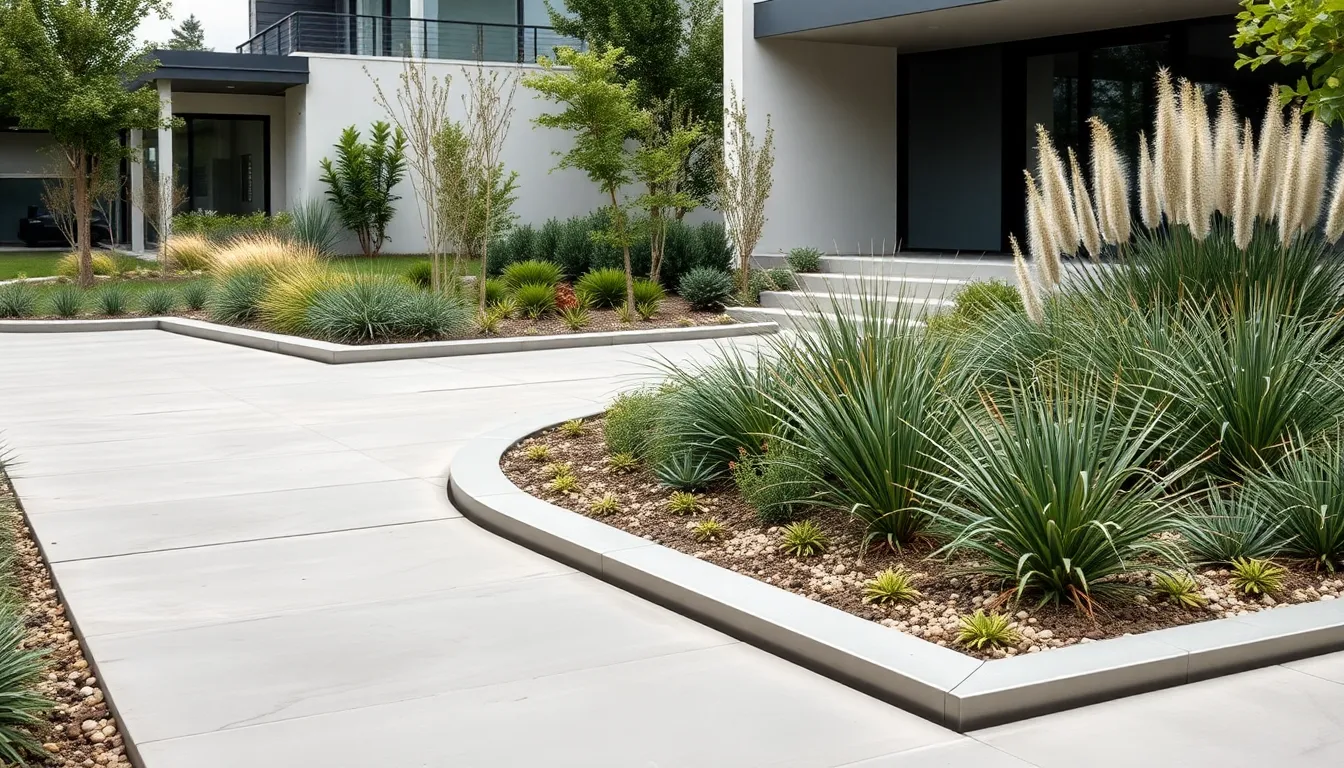
Metal edging systems offer the perfect solution for creating sleek, contemporary garden boundaries that complement modern architectural styles. We’ll explore the most effective metal options that combine durability with sophisticated design aesthetics.
Steel Edging for Contemporary Looks
Steel edging delivers exceptional strength and creates clean, geometric lines that define modern industry designs. We recommend this material for homeowners seeking long-lasting boundaries that can withstand heavy foot traffic and weather conditions. Its rigid structure makes it ideal for creating precise angles around rectangular planting beds, walkways, and contemporary water features.
Professional landscapers often choose steel for its ability to maintain sharp edges over time without bending or warping. We’ve found that steel edging works particularly well when paired with minimalist plant selections like ornamental grasses or architectural succulents. The material’s neutral appearance allows bold plant textures and colors to take center stage while providing the structural framework needed for cohesive design.
Aluminum Options for Durability
Aluminum edging combines lightweight handling with impressive rust resistance, making installation projects more manageable for DIY enthusiasts. We appreciate how this material maintains its appearance without requiring regular maintenance treatments or protective coatings. Its non-corrosive properties make it particularly suitable for coastal areas where salt air can damage other metal options.
Installation becomes significantly easier with aluminum’s flexibility, allowing us to create gentle curves around tree rings and flowing garden borders. We’ve noticed that aluminum edging integrates seamlessly with both traditional and modern industry styles while offering the longevity that homeowners expect from their investment. The material’s ability to bend without breaking makes it perfect for creating organic shapes that follow natural garden contours.
Cor-Ten Steel for Industrial Appeal
Cor-Ten steel develops its distinctive rust-like patina over time, creating an industrial aesthetic that adds character to contemporary landscapes. We find this weathering steel particularly appealing because it forms a protective oxide layer that actually prevents further corrosion while maintaining its structural integrity. The evolving appearance means your edging becomes more visually interesting as seasons pass.
Edge Right and similar suppliers offer Cor-Ten steel edging that works exceptionally well for separating gravel areas from planted sections. We recommend this material for homeowners who want their industry to reflect modern architectural trends while embracing the beauty of natural weathering processes. The warm, earthy tones that develop complement both drought-tolerant plantings and lush garden beds, making it versatile for various design approaches.
Build Raised Garden Beds With Timber Edging
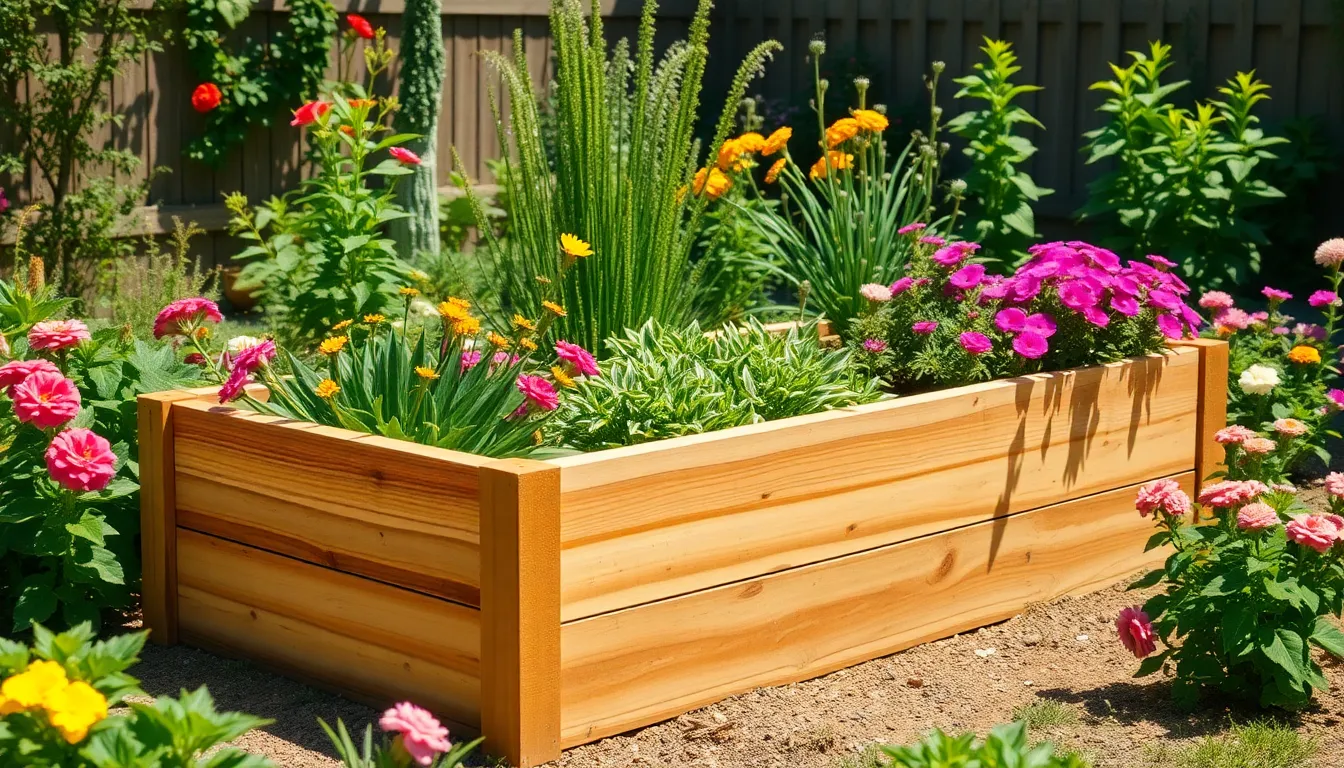
Timber edging transforms flat garden spaces into structured raised beds that enhance both plant health and visual appeal. We’ll explore three primary timber options that offer durability and distinct aesthetic qualities for your landscaping projects.
Pressure-Treated Lumber Considerations
Pressure treated lumber provides exceptional durability for raised garden bed construction, resisting rot and insect damage for years. We recommend selecting lumber specifically rated for ground contact to ensure maximum longevity in outdoor conditions. Chemical treatments in pressure treated wood may leach into surrounding soil over time, potentially affecting nearby plants and vegetables.
Installation becomes straightforward with pressure treated timber since it maintains structural integrity even when partially buried. We suggest using galvanized screws or brackets to secure corners and prevent splitting during temperature changes. Cost effectiveness makes pressure treated lumber an attractive option for large garden bed projects where budget considerations matter.
Safety precautions include wearing gloves during installation and avoiding burning pressure treated wood scraps. We advise against using this lumber type for edible plant beds due to potential chemical migration into soil and root systems.
Cedar and Redwood Natural Options
Cedar timber offers natural resistance to rot and insects without requiring chemical treatments, making it ideal for organic gardening applications. We find cedar’s pleasant aroma adds sensory appeal to garden spaces while providing reliable structural support for raised beds. Natural oils within cedar wood repel termites and other pests that typically damage untreated lumber.
Redwood presents similar benefits with its naturally occurring tannins that protect against decay and insect infiltration. We appreciate redwood’s rich color variations that complement diverse landscaping styles from rustic to contemporary designs. Both cedar and redwood maintain their structural integrity for decades when properly installed and maintained.
Installation techniques for natural timber require pre drilling to prevent splitting, especially near board ends. We recommend applying natural wood sealers annually to preserve color and extend lifespan. Higher initial costs for cedar and redwood deliver long term value through reduced replacement needs and enhanced garden aesthetics.
Sustainability considerations favor these options since both cedar and redwood come from renewable forest resources. We suggest sourcing from certified sustainable forestry operations to support responsible harvesting practices.
Railroad Tie Installation Methods
Railroad ties create substantial raised garden beds with rustic charm that complements traditional and farmhouse landscaping styles. We recommend inspecting ties carefully for signs of rot or chemical treatment before installation since older ties may contain creosote. Heavy weight requires mechanical assistance or multiple people for safe positioning and alignment.
Foundation preparation involves excavating a level trench approximately 3 inches deep to accommodate the first course of ties. We suggest adding a gravel base for improved drainage and stability in areas with clay soil or poor water management. Overlapping joints at corners creates stronger connections than simple butt joints.
Securing methods include drilling pilot holes and using industry spikes or rebar to anchor ties in position. We find that staggering vertical joints between courses improves structural stability and prevents shifting over time. Multiple course installations require checking level frequently to maintain even bed heights.
Replacement considerations become important since railroad ties deteriorate over 8 to 12 years depending on climate conditions. We advise budgeting for eventual replacement and choosing tie sizes that allow for easy removal when needed. Alternative reclaimed timber options provide similar aesthetic appeal with potentially longer lifespans.
Establish Permanent Borders With Concrete Edging
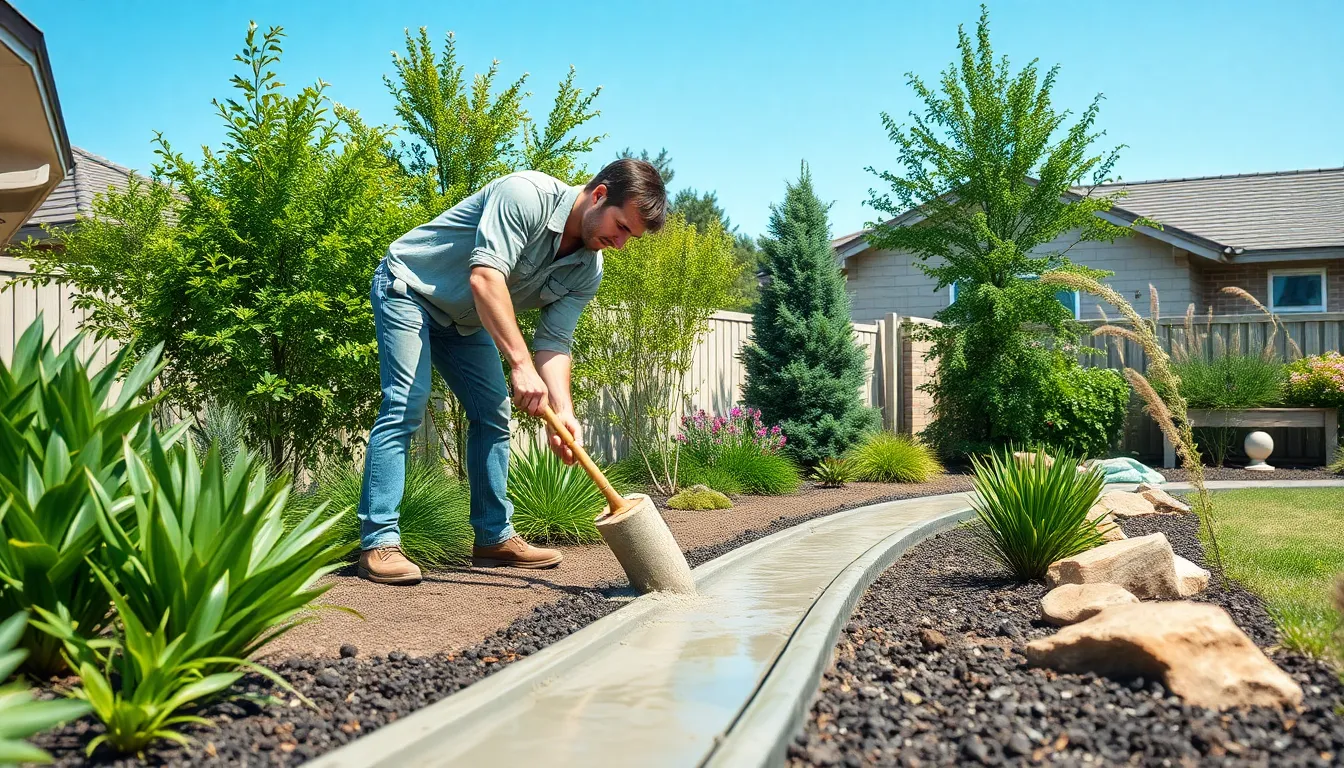
Concrete edging delivers unmatched durability and creates permanent boundaries that’ll define your industry for decades. We’ll explore three proven concrete methods that transform ordinary garden borders into professional-grade features.
Poured Concrete Techniques
Poured Concrete Techniques involve creating liquid concrete forms that establish solid, continuous borders throughout your industry. We begin by excavating a trench 4-6 inches deep and 3-4 inches wide along your desired border line. Form boards made from 2×4 lumber help shape the concrete and maintain straight edges during the pouring process.
Mixing concrete to the proper consistency prevents cracking and ensures long-lasting results. We recommend using a standard concrete mix with a 3:2:1 ratio of gravel, sand, and Portland cement. Pour the mixture slowly into your prepared forms, working in 10-foot sections to maintain control and prevent setting issues.
Finishing touches include smoothing the surface with a float and creating decorative grooves using a concrete grooving tool. We allow 24-48 hours for initial curing before removing forms, then apply a concrete sealer after 7 days for maximum protection against weathering.
Decorative Concrete Block Systems
Decorative Concrete Block Systems use interlocking blocks that create versatile edging arrangements in various patterns and designs. We select blocks based on your industry style, choosing from options like stackable retaining wall blocks, decorative garden blocks, or specialty interlocking pavers.
Installation begins with preparing a level base using 2-3 inches of compacted gravel or sand. We position the first course of blocks along your border line, checking for level alignment every 3-4 blocks. Each subsequent course interlocks with the previous layer, creating a stable wall structure.
Pattern variations include running bond, stack bond, and offset designs that add visual interest to your edging. We backfill behind the blocks with drainage gravel to prevent water buildup and soil pressure. Most decorative block systems allow for curves and angles, making them perfect for irregular garden shapes.
Stamped Concrete Pattern Ideas
Stamped concrete patterns create intricate textures and designs that mimic materials like natural stone, brick, or slate. We begin by pouring standard concrete, then apply color hardeners and release agents before the stamping process begins. Timing is critical since stamping must occur during the concrete’s plastic state.
Popular pattern options include cobblestone, ashlar slate, and running bond brick that complement various architectural styles. We use specialized stamping tools and mats to press these patterns into the concrete surface, working systematically to maintain consistent depth and alignment.
Color combinations enhance the stamped concrete’s appearance through integral coloring and acid staining techniques. We apply base colors during mixing, then add accent colors with stains or antiquing agents after the concrete cures. Sealing the finished surface protects against weathering and maintains the pattern’s definition for years to come.
Explore Creative DIY Edging Material Alternatives
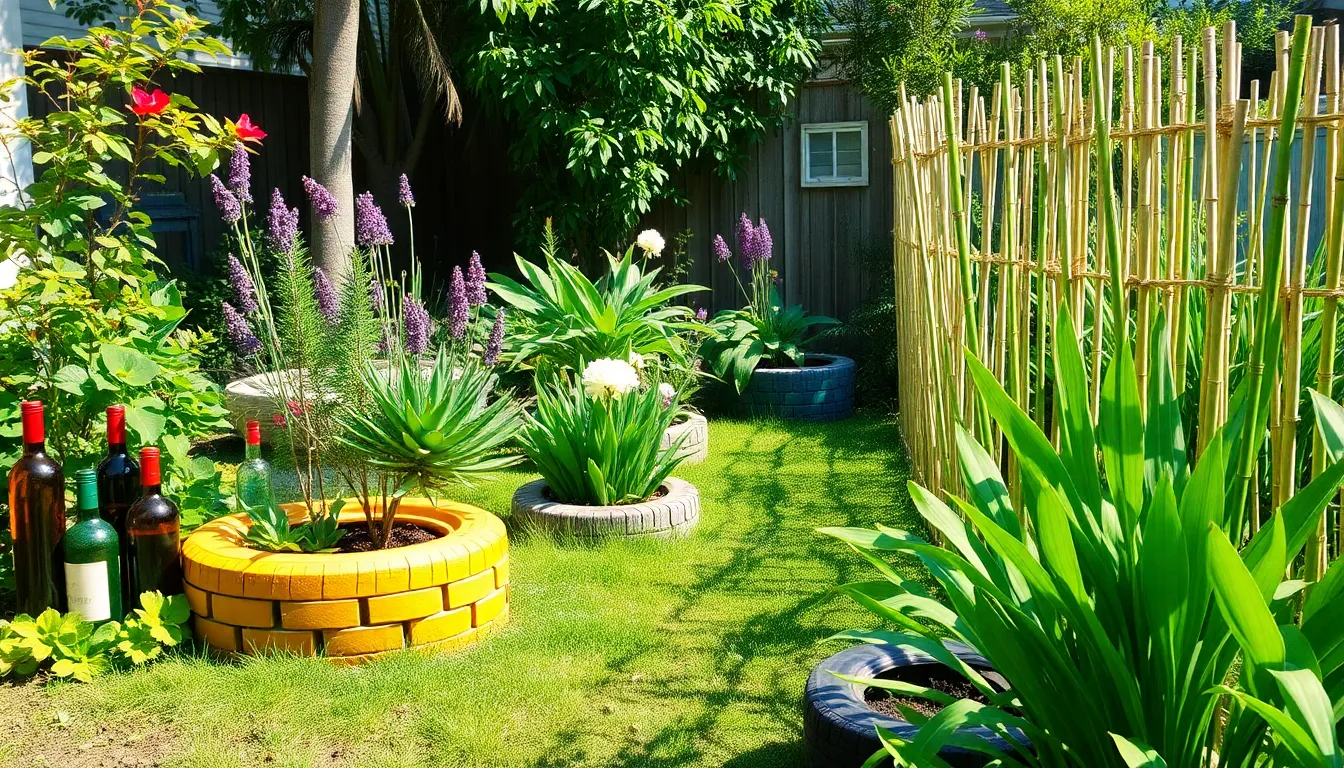
Transform your garden with innovative materials that showcase your creativity while staying budget friendly. These unique alternatives prove that stunning landscaping doesn’t require expensive specialty products.
Repurposed Bottle Borders
Upturned wine bottle edging creates a whimsical garden border that’s both sustainable and eye catching. We love how this eco friendly approach repurposes materials that would otherwise end up in landfills while adding colorful character to garden spaces.
Installation requires minimal tools and preparation. Simply dig a narrow trench approximately 4 inches deep along your desired border line. Position bottles neck down with about two thirds buried underground to ensure stability and weather resistance.
Color coordination enhances the overall aesthetic impact of bottle borders. Green wine bottles blend naturally with foliage while brown bottles complement earth tones in rustic garden settings. Clear bottles reflect sunlight beautifully and work well in contemporary industry designs.
Cleaning bottles thoroughly before installation prevents unwanted odors and maintains a professional appearance. Remove all labels and adhesive residue using warm soapy water and a scraping tool. Allow bottles to dry completely before placing them in the prepared trench.
Tire and Rubber Edging Answers
Recycled tire edging offers an eco friendly choice that transforms waste materials into durable garden borders. We appreciate how old tires can be cut into various shapes or used whole to create colorful and long lasting boundaries that withstand extreme weather conditions.
Cutting techniques allow for creative customization of tire borders. Use a sharp utility knife or reciprocating saw to create decorative scalloped edges or geometric patterns. Sand rough cuts smooth to prevent injury and create a finished appearance.
Painting tires extends their decorative potential beyond natural black rubber. Apply primer specifically designed for rubber surfaces before adding acrylic paint in colors that complement your garden palette. Bright colors like yellow and red create cheerful accents while earth tones blend seamlessly with natural surroundings.
Stacking whole tires creates raised planting areas perfect for vegetables or flowers. Fill tires with quality potting soil and plant directly inside for instant container gardens. This method works especially well for herbs and compact vegetables that benefit from contained growing spaces.
Bamboo and Reed Fencing
Bamboo edging provides a natural rustic look that complements Asian inspired gardens and contemporary landscapes alike. We find bamboo’s durability impressive as it resists weather damage while offering versatility in stake configurations and woven fence applications.
Installation methods for bamboo stakes require pre drilling holes to prevent splitting. Drive stakes approximately 6 inches into soil using a rubber mallet to maintain structural integrity. Space stakes evenly 12 to 18 inches apart for optimal stability and visual appeal.
Reed fencing delivers similar natural aesthetics with its own unique texture and appearance. These lightweight panels create serene natural ambiance in gardens while providing effective barriers for defining planting areas. Reed fencing installs easily using zip ties or wire to secure panels to existing posts.
Maintenance requirements for both bamboo and reed remain minimal with proper installation. Apply clear wood preservative annually to extend lifespan and prevent moisture damage. Inspect connections regularly and replace damaged sections promptly to maintain border integrity throughout growing seasons.
Consider Professional Installation Versus DIY Approaches
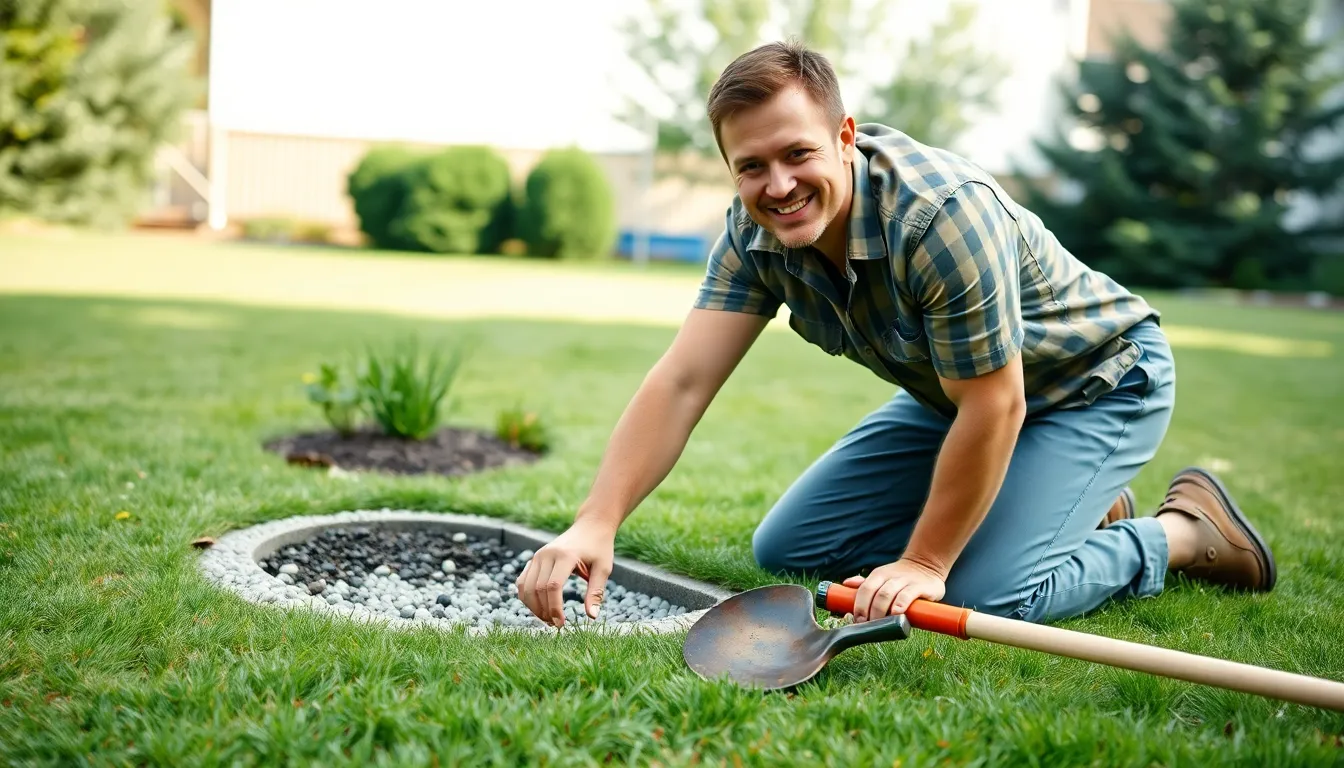
Choosing between professional installation and DIY approaches for landscaping edging significantly impacts your project’s outcome and budget. We’ll examine the key factors to help you make the best decision for your exact situation.
Cost-Benefit Analysis
Professional installation offers cleaner lines and superior longevity, making it a worthwhile investment for permanent edging answers. Contractors bring specialized expertise that ensures proper installation techniques, particularly for complex materials like concrete or stone edging systems.
DIY approaches provide substantial cost savings, especially for simpler materials like gravel or recycled rubber edging. We can complete these projects using basic tools and weekend labor, reducing overall expenses by 50-70% compared to professional services.
Long-term maintenance costs favor professional installation for materials like stone and metal edging, which require minimal upkeep over decades of use. DIY installations may need more frequent repairs and adjustments, particularly for flexible materials or improperly installed borders.
| Installation Type | Initial Cost | Maintenance Frequency | Longevity |
|---|---|---|---|
| Professional Stone/Metal | Higher | Minimal | Decades |
| DIY Gravel/Rubber | Lower | Moderate | 5-10 years |
| Professional Concrete | Highest | Very Low | 20+ years |
Tools and Equipment Requirements
DIY edging projects require basic landscaping tools including spades, rakes, weed barriers, and installation pegs for materials like gravel or rubber borders. Most homeowners already own these essential tools, making DIY installation accessible without additional equipment investments.
Professional installations use specialized edging tools designed for precise installation in compacted soil conditions. Contractors possess commercial-grade equipment that creates perfectly straight lines and handles challenging terrain that would be difficult for homeowners to manage.
Concrete edging demands professional-grade mixing equipment and forming tools that aren’t practical for homeowners to purchase for single projects. Rental costs for specialized concrete tools often approach professional installation prices, making DIY less economical for permanent answers.
Time Investment Considerations
DIY edging projects can typically be completed over a single weekend, depending on the area size and material complexity. Simple installations like recycled rubber or gravel edging require minimal preparation time and straightforward installation processes.
Professional installation often requires extended timeframes for preparation and installation, especially for large or intricate projects involving stone or concrete materials. Contractors must account for site preparation, material delivery, and proper curing times that extend beyond typical DIY schedules.
Complex designs with curved patterns or multi-level installations benefit from professional expertise that reduces overall project duration. We save important time by avoiding common DIY mistakes that require costly corrections and material replacement.
Weather delays affect professional projects more significantly due to scheduling constraints with multiple clients. DIY projects offer flexibility to work around weather conditions and personal schedules, allowing for project completion at our own pace.
Conclusion
We’ve explored a comprehensive range of edging answers that can transform any industry from ordinary to extraordinary. Whether you’re drawn to the timeless elegance of brick patterns or the sleek sophistication of modern metal systems each option offers unique benefits for creating defined garden spaces.
The key to successful edging lies in choosing materials that complement your home’s architecture and match your maintenance preferences. From sustainable living edges that grow more beautiful over time to durable concrete answers that provide decades of service there’s an edging style that fits every budget and vision.
Remember that quality edging isn’t just about aesthetics—it’s an investment in your property’s long-term value and your garden’s health. With the right approach you’ll create stunning outdoor spaces that require less maintenance while delivering maximum visual impact for years to come.
Frequently Asked Questions
What is landscaping edging and why is it important?
Landscaping edging creates defined boundaries between different areas of your garden, such as separating grass from flower beds. It prevents grass from encroaching on planted areas, reduces maintenance time, and significantly improves your yard’s curb appeal by creating clean, professional-looking lines.
What are the most popular edging materials for gardens?
The most popular edging materials include brick (classic and recycled), flexible plastic, natural stone and fieldstone, metal systems (steel, aluminum, Cor-Ten), timber options (cedar, redwood, pressure-treated lumber), concrete, and creative DIY alternatives like repurposed bottles or bamboo fencing.
How do I install brick edging properly?
To install brick edging, prepare the ground by digging a trench, place bricks end-to-end in your desired pattern, and backfill with soil. For herringbone patterns, plan your layout carefully and ensure proper spacing. Bury bricks partially for stability and create smooth curves that follow your garden’s natural flow.
What is flexible plastic edging and when should I use it?
Flexible plastic edging creates smooth, flowing lines that complement natural garden curves. It’s ideal for organic garden designs and areas where rigid materials won’t work. Choose UV-resistant materials for longevity and ensure proper installation by digging trenches, leveling, and securing the edging firmly.
Are living plant borders effective for garden edging?
Yes, living plant borders create sustainable, low-maintenance garden boundaries that grow more beautiful over time. Options include low-growing perennials like creeping thyme, ornamental grasses for texture and movement, and drought-tolerant succulents. These living edges suppress weeds naturally and require less maintenance than hardscaping.
What’s the difference between steel and aluminum edging?
Steel edging offers superior strength and creates clean, geometric lines perfect for modern landscapes and high-traffic areas. Aluminum edging is lightweight, rust-resistant, and easier to install with more design flexibility. Both provide sleek, contemporary appearances that complement modern architectural styles.
Should I hire professionals or install edging myself?
DIY installation works well for simpler materials and offers significant cost savings. Professional installation provides cleaner lines, superior longevity, and expertise with complex materials like concrete or metal systems. Consider your skill level, available time, and the permanence of your desired solution when deciding.
How long does different edging materials last?
Durability varies by material: concrete and stone edging can last decades with minimal maintenance, cedar and redwood timber last 10-15 years with proper care, pressure-treated lumber lasts longer but may have chemical concerns, while plastic edging typically lasts 5-10 years depending on UV exposure and quality.
What tools do I need for DIY edging installation?
Basic DIY edging requires a spade or edging tool, level, measuring tape, rubber mallet, and wheelbarrow. Specific materials may need additional tools: concrete requires mixing equipment, timber needs saws and drill, while stone installation benefits from a tamper and landscape fabric for weed suppression.
How do I maintain my garden edging?
Regular maintenance includes inspecting for damage, trimming vegetation that grows over edges, cleaning debris for proper drainage, and replacing damaged sections promptly. Living edges need occasional pruning, while metal and concrete edging require minimal upkeep beyond periodic cleaning and checking for stability.

